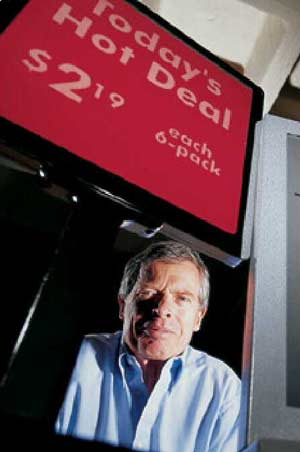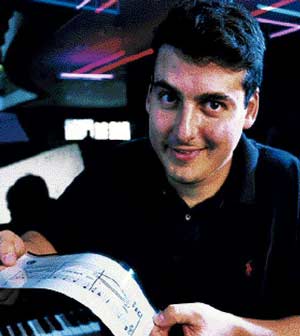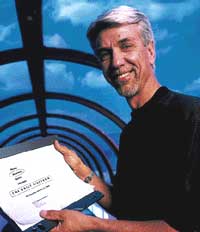The Electronic Paper Chase
SUBTOPICS
 |
| OFFERING A GLIMPSE of a future with rewritable periodicals, this E Ink Corporation prototype "prints" text using electronic ink. Voltages are supplied to the ink by a thin-film-transistor panel, from IBM. The panel is 800 by 600 pixels; each pixel is formed by charged pigment--the "ink." Electrically erasable programmable memory sticks (sitting atop display, at right) are used in setting the text. |
| SAM OGDEN |
Yet ink on paper is lacking in one of the essential traits of computer displays: instantaneous erasure and reuse, millions of times without wearing out. Electronic ink on paper with this ability could usher in an era of store signs and billboards that could be updated without pulping acres of trees; of e-books that embody the familiar tactile interface of traditional books; of magazines and newspapers delivered wirelessly to thin, flexible page displays, convenient for reading, whether on crowded subways or desert islands.
There have been intermittent efforts to produce such electronic paper over the past three decades, but only recently has research gone into full swing. The day when Scientific American and other periodicals are routinely published in this medium may come before 2010, thanks to competition between two start-up firms. Both companies are offshoots of major research institutions: the Xerox Palo Alto Research Center (PARC) and the Massachusetts Institute of Technology Media Laboratory. Both firms base their core technologies on tiny, electrically charged beads, with the imaging capability controlled electronically. And they are not only racing each other to commercialize their efforts but are also anticipating competition from the organic light-emitting diodes that are beginning to emerge from laboratories.
Spinning Off Electric Paper
The earliest attempt at "electric paper," as it was originally called, came as a response to the poor visual quality of the computer displays available in the early 1970s. "The CRTs [cathode-ray tubes] were too dim," recalls Nicholas K. Sheridon. "I wanted to find a display material with as many of the properties of paper as possible. Finding a paper substitute was not my main motivation."
 |
| THREE DECADES AFTER his initial vision of creating an electronic display with as many of the features of paper as possible, Nicholas K. Sheridon of Gyricon Media demonstrates the feasibility of SmartPaper displays. The displays, which are now being marketed under the MaestroSign brand, could save individual stores thousands of dollars in signage costs. |
| ERIC MILLETTE |
He would have to wait still longer for his technology to make its way into a commercial product. First it had to be spun off into a separate company. In December 2000 Gyricon Media was launched as an independent venture headquartered in Palo Alto, Calif. (with Xerox retaining a majority financial stake in the company). By March 2001 the new firm made its first product announcement at the GlobalShop trade show for retail store displays in Chicago. On the floor of the McCormick Place convention center, Sheridon, now Gyricon Media's research director, could be seen admiring a smoky green 11-by-14-inch panel on an aluminum stand, the kind you find on department store tables. This sign cycled through several sales messages and the price "$89.99" in slightly speckled type, and it would be powered by its three AA batteries for up to two years. Nearly 30 years after its original inspiration, Sheridon's electric paper was finally available--with limitations.
This prototype of what is now being marketed as SmartPaper was to be field-tested throughout the second half of 2001 in 15 signs at the Macy's department store in Bridgewater, N.J. Resolution was the equivalent of a modest 100 dots per inch (dpi). In comparison, the resolution of the print version of this magazine is 1,200 dpi. And because inflexible electrodes were used to activate the pliant SmartPaper material (a silicone rubber film soaked in oil to allow the bichromate beads to rotate), this version of e-paper was rigid as a board.
By 2002 Sheridon expects the commercial sale of similarly sized signs that can be easily updated via a wireless network. To a retail client like Federated Department Stores, Macy's parent company, which is currently spending more than $250,000 a week on changing its in-store signs, such renewable signage could prove highly desirable. Also due out next year are smaller SmartPaper signs meant to keep prices up-to-date on supermarket shelves, where inaccurate numbers can turn into expensive fines under item-pricing laws.
 |
| JOSEPH JACOBSON of the M.I.T. Media Lab and E Ink seeks to create the effect of real paper that prints itself. His ultimate goal is a cybercodex, "the last book," a bound volume of hundreds of e-ink pages with enough memory chips to store the entire contents of the Library of Congress. |
| SAM OGDEN |
Nevertheless, as paperlike as it may become, this electronic paper may never feel exactly like the original. Sheridon admits, "It will never be as light as paper. Paper is about four mils thick; this will always be 12 or 15 mils thick. But it doesn't have to exactly replicate paper to be useful."
Making a Mark with E-Ink
Real paper able to print itself was the starting point for Gyricon Media's principal rival in the digital paper market. Independent of Sheridon, in 1995 Joseph Jacobson, then a Stanford University physics postdoctoral researcher, was looking for an interesting problem to tackle. He came up with the notion of a book full of pages that could be electronically reconfigured to display the text of King Lear or General Relativity or any of hundreds of other tomes stored in silicon memory in the book's spine.
For his imaging technology, Jacobson turned to electrophoresis, the movement imparted by an electric field to charged particles that are suspended in a liquid. In place of pigment-carrying beads, he used transparent polymer microcapsules containing a blue liquid dye and white particles. When the positively charged particles of white titanium dioxide remain on the viewable side of the microcapsules, they produce a white page; a negative charge on an electrode below a capsule will draw these particles to the other side, creating an inklike image in their place--until an opposite electrical pulse sends the white pigment back. Reversing this process produces white letters on a dark background. Suspended in water, the microcapsules can be printed on paper or electrode-bearing materials just like ink. Jacobson called this "electrophoretic ink," or e-ink.
Appointed to an assistant professor position at the M.I.T. Media Lab in 1995, he continued his research into e-ink with two of his undergraduate students, J. D. Albert and Barrett Comiskey. In 1997 the three of them, along with Harvard Business School graduate Russell J. Wilcox, founded E Ink Corporation in Cambridge, Mass. The start-up soon attracted funds from venture-capital firms, corporate investors, including Motorola and the Hearst Corporation, and an R&D grant from the Defense Advanced Research Projects Agency (DARPA).
 |
| HOW E-PAPER WORKS
Both technologies being developed commercially for electronically configurable paperlike displays rely on microscopic beads that change color in response to the charges on nearby electrodes. Gyricon Media's SmartPaper uses two-tone solid beads that twist around in place (top). Inventor Nicholas K. Sheridon's breakthrough for producing tiny symmetrical beads involved pouring black and white resins onto a rapidly spinning disk. E Ink's Electronic Ink employs see-through microcapsules containing pigment chips that move through a liquid medium (bottom). Manufacturing applies standard techniques developed for microencapsulated coatings on business forms. |
| LAURIE GRACE |
Jacobson is not involved in E Ink's day-to-day operations (he serves on its board of directors, while devoting most of his time to his position as director of the Molecular Machines Research Group at the Media Lab). In his stead, Michael D. McCreary is E Ink's vice president of research and development. At the firm's offices in an office park on the outskirts of Cambridge, he explains that in the company's business plan, store signs were always considered a first step in proving the viability of electronic ink. "Our next step is developing high-resolution displays for portable devices," McCreary says. He shows a rigid, Palm Pilot-style screen (with better contrast, at 80-dpi resolution) that's viewable at wider angles than the standard black-and-white liquid-crystal display (LCD) on a handheld computer.
In February, Philips Components, a division of Royal Philips Electronics in the Netherlands, secured exclusive global rights for a period of time to manufacture and sell display modules using E Ink technology for personal digital assistants (PDAs) and electronic books in exchange for a $7.5-million investment in the company. With this version of electronic paper drawing as little as one hundredth the power of a comparable LCD screen, Philips is banking on a competitive advantage in battery life for its handheld devices, which will be available within the next two years.
Another corporate partner, Lucent Technologies, licensed its Bell Labs-developed plastic transistor technology to E Ink, while also investing in the company. In November 2000 this alliance demonstrated the first flexible electronic-ink display--a five-by-five-inch screen with the consistency and thickness of a computer mouse pad and just 256 cornflake-size pixels, which cycled through checkerboard patterns, the companies' names and the E Ink corporate logo. This demo was a proof-of-concept that the active-matrix circuitry for addressing E Ink's microcapsules could be fabricated with plastic materials rubber-stamped onto a flexible sheet of plastic.
 |
| ROBERT STEINBUGLER, head of IBM's corporate strategic design program, shows a rubberized, flexible portfolio-style display concept with eight two-sided pages made of digital paper. The eNewspaper combines the familiar experience of flipping pages with the convenience of instantly rewritable text. |
| SAM OGDEN |
In May, E Ink and Japan's Toppan Printing Company introduced a prototype color electronic-ink display. Using Toppan's color filter arrays, which are now widely deployed in standard LCDs, the demonstration screen showed eight colors. Using this technology, E Ink expects to produce displays capable of showing 4,096 colors, comparable to handheld computer and game screens.
These recent prototypes have brought E Ink closer to its ultimate goal. "We call it 'radio paper,'" McCreary explains of the third stage in the E Ink business plan. This will be flexible digital paper with high-resolution-color capabilities that could be reconfigured via a wireless data network. He anticipates that radio paper will be a commercial reality by 2005, at which point similar technologies may also be widely available from Gyricon and other sources.
E Ink will also be competing with organic light-emitting diodes. Carbon-based compounds similar to the plastics used in E Ink and Lucent's flexible display can produce light-emitting semiconductors that are also pliable and relatively energy-efficient. That this alternative to electronic paper is being developed by Eastman Kodak, IBM and other well-financed firms should soon make this technology a credible challenger.
The Last Book
Almost from the beginning, Jacobson's long-term vision for e-ink has included "the last book": several hundred bound pages of self-printing paper with a separate processor imprinted on each page and enough memory chips in the hardcover volume's spine to store the entire contents of the Library of Congress. With a single page of e-inked paper able to replicate any stored page of text, graphics or even video, why bother binding together so many pages? According to Jacobson, one reason is to engage a reader's spatial memory: thumbing through a book-length work makes it easier to locate a particular passage or illustration.
Somewhere between Jacobson's e-tome and Sheridon's e-scroll, there's another format that electronic paper publishing could adopt. This one is an updated variation on early printing's folios--binary multiples (8, 16 or 32) of pages cut from a single large printed sheet. In 1999 Robert Steinbugler, head of IBM's corporate strategic design program, unveiled a design prototype for the eNewspaper--a rubberized, flexible, portfolio-style display device containing eight two-sided pages made of digital paper (actually plastic mock-ups, for now). Based on interviews with newspaper publishers and readers, Steinbugler concluded that a sheaf of pages afforded the ability to flip back and forth among stories without having to redraw their text, while also offering the serendipitous juxtaposition of stories that still distinguishes newspapers in print from their online, one-screen-at-a-time versions.
Given today's accelerated quest for electronic paper, it may not be too long before Scientific American readers are offered a choice of e-folio, e-hardcover or e-papyrus editions.
Related Links:
Information about Electronic Reusable Paper is available on the Xerox PARC Web site at www.parc.xerox.com/dhl/projects/gyricon/
Information about SmartPaper is available on the Gyricon Media Web site at www.gyriconmedia.com/smartpaper/index.asp
What Is Electronic Ink? Available on the E Ink Web site at www.eink.com/technology/index.htm
The Last Book. Joseph Jacobson in IBM Systems Journal, Vol. 36, No. 3; 1997. Available at www.research.ibm.com/journal/sj/363/jacobson.html
The Author
Steve Ditlea is a freelance journalist based in Spuyten Duyvil, N.Y. He has been covering technology since 1978.
© 2001 Steve Ditlea. All rights reserved. Reproduction in whole or in part without permission is prohibited.